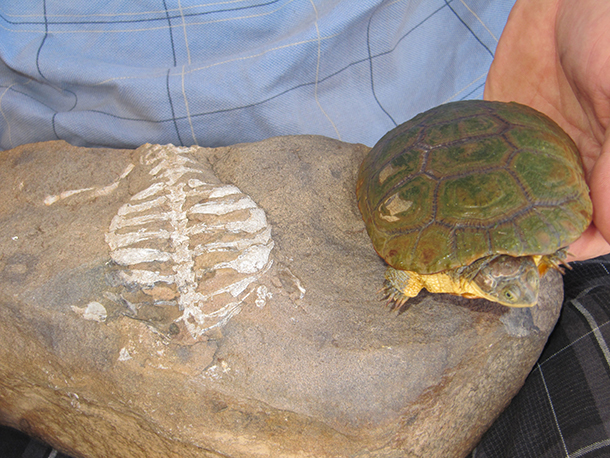Science Note: Ancient Turtle Revelation
Air Date: Week of October 14, 2016

Turtle shells developed out of a modified rib cage (Photo: Luke Norton)
A new fossil found by an eight-year-old boy is helping researchers discern the origins of turtle shells. The specimen suggests that shells arose from an adaptation for burrowing underground and that only later did they acquire a protective function.
Transcript
[SCIENCE NOTE THEME]
RUTTY: Kobus Snyman was just eight years old when he found a fossilized turtle on his father’s farm in South Africa. The fossil he uncovered was 260 million years old.
In fact, it’s a member of the oldest species of turtle that we know of – a partially shelled reptile called Eunotosaurus africanus. This specimen preserves parts of the ancient turtle skeleton that researchers have never seen before. It’s helping scientists at Wits University in Johannesburg piece together the origin of turtle shells – and it’s not for protection, as you might expect.
We already know how turtles evolved to have shells. Unlike other armored quadrupeds like armadillos and pangolins – whose shells are modified scales – turtles developed theirs by broadening the ribs and widening their bones into flat plates.
But scientists say why turtles developed shells is a puzzle. Across time and geography, there’s little variation in the rib cages of four-legged animals, because ribs are vital for breathing and movement. The broadened rib cage in turtles interferes with their lungs and makes walking slower and more awkward.
But Snyman’s specimen points to a possible explanation for this clunky trait: an ancient turtle hand. Big, strong, and clawed, it looks like the forelimb of an animal that digs.
Studying the anatomy and cell structure of other broad-ribbed animals such as anteaters, researchers found that wide rib cages are associated with burrowing. In the arid climate of ancient South Africa, the first turtles likely developed shells as a way to escape the heat underground. The shell’s protective function is just a byproduct – a handy side effect of a trait that evolved for different reasons entirely.
That’s this week’s note on emerging science. I’m Charlotte Rutty.
[SCIENCE NOTE THEME]
Links
The new study, entitled “Fossorial Origin of the Turtle Shell”:
A time lapse of turtle shell evolution, created by the study’s lead author Tyler Lyson
Living on Earth wants to hear from you!
Living on Earth
62 Calef Highway, Suite 212
Lee, NH 03861
Telephone: 617-287-4121
E-mail: comments@loe.org
Newsletter [Click here]
Donate to Living on Earth!
Living on Earth is an independent media program and relies entirely on contributions from listeners and institutions supporting public service. Please donate now to preserve an independent environmental voice.
NewsletterLiving on Earth offers a weekly delivery of the show's rundown to your mailbox. Sign up for our newsletter today!
 Sailors For The Sea: Be the change you want to sea.
Sailors For The Sea: Be the change you want to sea.
 The Grantham Foundation for the Protection of the Environment: Committed to protecting and improving the health of the global environment.
The Grantham Foundation for the Protection of the Environment: Committed to protecting and improving the health of the global environment.
 Contribute to Living on Earth and receive, as our gift to you, an archival print of one of Mark Seth Lender's extraordinary wildlife photographs. Follow the link to see Mark's current collection of photographs.
Contribute to Living on Earth and receive, as our gift to you, an archival print of one of Mark Seth Lender's extraordinary wildlife photographs. Follow the link to see Mark's current collection of photographs.
 Buy a signed copy of Mark Seth Lender's book Smeagull the Seagull & support Living on Earth
Buy a signed copy of Mark Seth Lender's book Smeagull the Seagull & support Living on Earth

